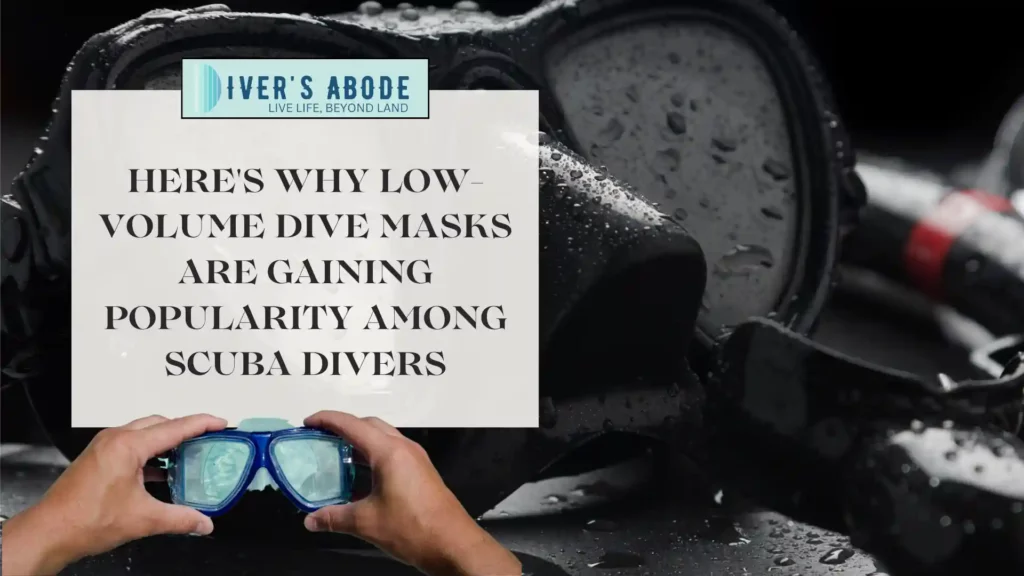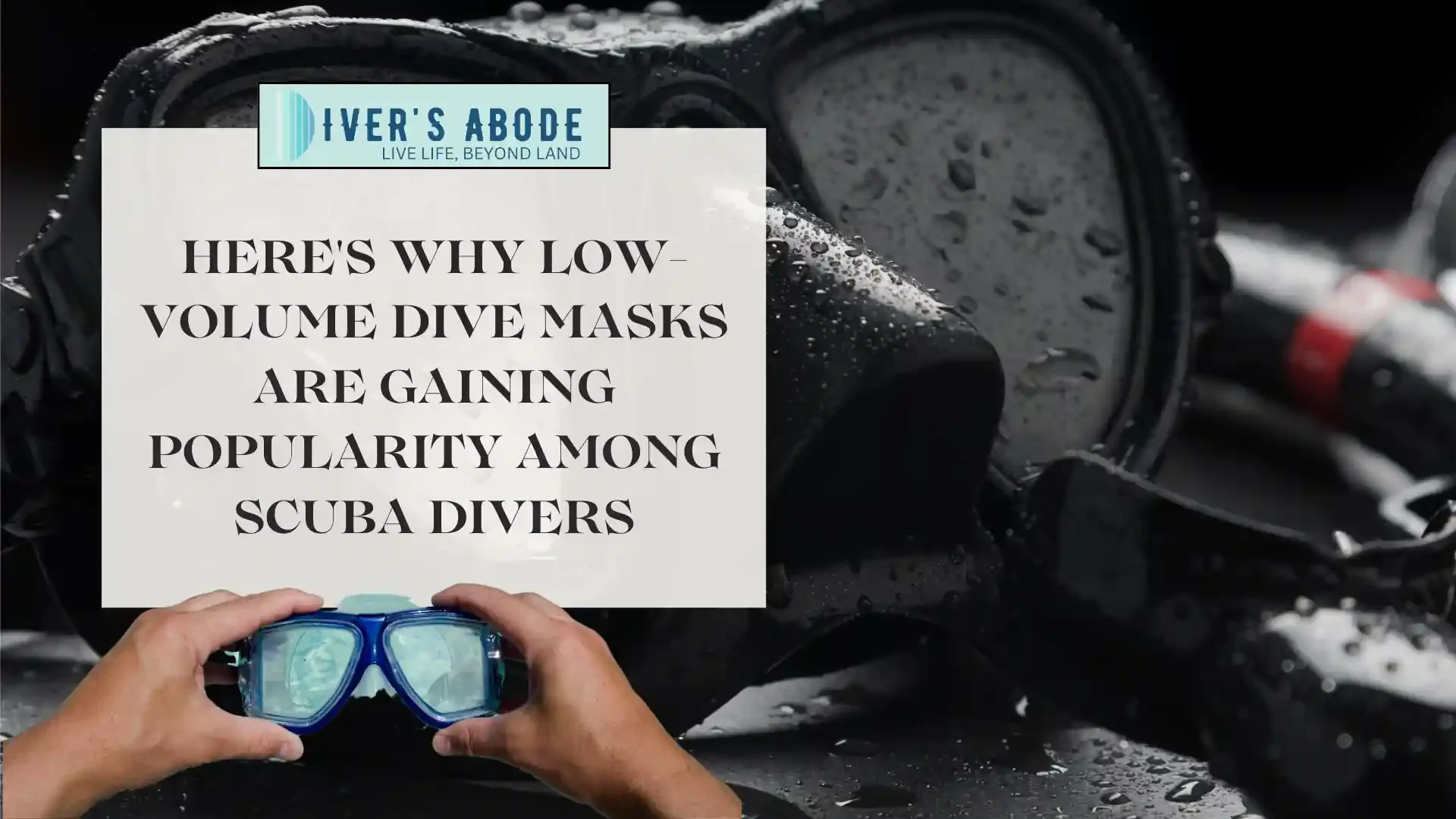When you see a dive mask described as “low volume,” this refers to the internal air space between the lens and your face. But what does volume mean in this context and how is it measured? And what even are these masks doing all the way out here in the scuba diving community instead of free divers?
The volume of a mask is quantified in milliliters (mL) or cubic centimeters (cc). It represents the total amount of air that is contained inside the mask skirt once it creates a seal against your face. Standard mask volumes tend to range from 300 – 600 mL. Low-volume masks have an air volume of around 100 – 300 mL.
To determine a mask’s volume, manufacturers use water displacement methods. The mask is filled with water and then the water is drained into a graduated cylinder to measure the volume. A lower volume indicates the mask skirt is closer to the face.
Table of Contents [show]
The Benefits of Choosing a Low-Volume Scuba Diving Mask
So why are these masks experiencing a surge in popularity among recreational divers? There are several reasons you might want a low-volume diving mask compared to a high-volume option.

More Comfortable and Diverse Fit
The most obvious benefit is comfort, duh. With less interior volume, the mask creates less pressure on your face. This avoids uncomfortable squeezing sensations during descent. These masks are great for divers with smaller or rounder facial structures.
These masks are also less prone to dislodging from your face during contact with high currents.
Offers Better Visibility
Since these masks diminish the distance between your eyes and the lens, visibility gets a whole lot better with fewer chances of glare and double vision caused by extreme light refraction through the lens.
Not only the lens, but the skirt of the mask is also nearer to the diver’s face which significantly improves peripheral vision as well as vertical vision.
Easier to Clear and Equalize
Less air space inside the mask also makes masks easier to clear when you need to equalize pressure. It requires less air to blow against the lower volume to force out any water. This also makes purging more effortless if water leaks in. The lower volume requires less equalization and air compression, so you can be done with your pre-dive shenanigans (including warm-up exercises) quickly and descend early.
Neutral Buoyancy Becomes a Bit Easier
The lower air volume in low-volume masks means less positive buoyant lift, allowing divers to have more neutral underwater trim.
A typical high-volume mask likely has around 50-100g of positive buoyancy force while in a standard low-volume mask, the buoyancy force may be reduced to 25-75g.
So switching from a 500 mL standard mask down to a 150 mL low-volume mask could decrease the buoyancy offset by around 50g, or 1.8 ounces.
Apart from that, clearing a low-volume mask underwater also purges less air, reducing significant buoyancy shifts.
Goes Hand-In-Hand with Cold Diving Gear
Since these masks are less bulky, they fit and seal better when wearing a diving hood compared to larger masks. Your next shallow cold water diving just got a bit more comfortable.
One thing to keep in mind, low volumes provide less air insulation. This will amplify the facial coldness during long shallow dives in very cold water.
In the end, the reduced mask squeeze risk of a low-volume dive mask outweighs the slightly decreased thermal insulation. But choose a mask of volume over 150 mL (still in the low-volume range, don’t worry) if diving in extreme sub-freezing temperatures for extended periods.
Reduces the Intensity of Tooth Squeeze and Facial Barotrauma
Barodontalgia, more commonly known as “tooth squeeze” is a painful condition a lot of divers face and is caused by the change in air pressure that squeezes the space between your teeth. If you have diastema or tooth cavity the pain becomes much much worse. Now if you’re diving with dentures that’s an entirely different scenario.
Apart from that, in case of poor air equalization of your mask, there’s a chance of getting mask squeeze, also known as facial barotrauma. Seen the pictures of those divers with bloodshot eyes almost popping out of their eye sockets? Yep, that’s the one.
Less air volume inside your low-volume mask reduces the intensity of Barodontalgia or facial barotrauma issues caused by air compression or poor equalization during the descent.
Factors that Should Influence Your Decision
When I say low-volume I don’t mean an absolute one. Low-volume dive masks don’t all have the same internal volume, but rather fall within a range within a range. To find the optimal fit adhere to the following tips
Facial Structure and Fit
The morphology of your face is key. Low-volume masks are suited for smaller faces, while larger volumes work better for high cheekbones or a prominent brow. Consider volume along with lens distance, skirt type, and overall fit.
Type of Diving Conditions
For warm shallow reef dives or even recreational dives, a low-volume mask can offer plenty of airflow. But for deep diving or diving in cold water, you may want more volume to allow for greater air expansion.
Personal Preference for Field of View
The volume also impacts the visual field of view underwater. Lower volumes provide a slightly more restricted view versus larger volume masks. Test different options to see your visibility preference.
What to Look for In the Ideal Low-Volume Dive Mask Model
With so many mask options on the market, here are a few design factors to evaluate when shopping for an ideal low-volume mask:
The Mask Volume
You should test the masks at increments like 100 mL, 150 mL, 200 mL, and so on to find the optimum volume for comfort.
Mask Skirt Type
Look for a low-volume mask with a comfortable dual-feathered edge or double-sealed silicone skirt. This will create the best seal on your face.
Lens Type
Low iron or optical glass lenses offer maximum visibility and light transmission. Tinted or colored lenses can help to reduce glare better.
Low-volume masks typically come in two variations in terms of the number of lenses: mono-lensed and twin-lensed and the preference boils down to your personal choice. I’ve found that whenever I used a twin lens the plane of each lens got messed up when the mask deformed even slightly under pressure which hampered my vision to a great degree.
Frame Design and Strap Style
Look for a rigid frame with a low profile fit. This avoids the mask squeezing against your face and keeps the volume stable.
Unlike mono straps in high-volume masks, dual adjustable straps that are easily detachable work best for getting an optimal low-volume fit, or the masks might dig in too tight on your face
Our Top 5 Recommended Low-Volume Dive Masks
Based on the criteria above, here are 5 of the top-performing low-volume masks on the market. Each of the recommended masks is tested either by me or by other members of Diver’s Abode.
| MODEL | VOLUME | FEATURES |
|---|---|---|
| Scubapro Spectra Mini | 130 mL | 1. The double-sealed feathered skirt provides an incredible seal |
| Atomic Venom Frameless | 100 mL < | 1. The dual silicone skirt offers a snug fit 2. Visibility is maximized with the low iron glass lens |
| DGX Ren Mask | 100 mL < | 1. Cheapest option with no compromise on durability. 2. Twin-tempered lenses might pose a double-vision problem during mask deformation. |
| Aqua Lung Micromask Ultra-Low Volume | 92 mL | 1. Lowest-volume branded mask available 2. The dual-pane lens delivers visibility across a huge field of view. 3. Ideal fit for kids. |
| TUSA Liberator Plus Frameless | 150 mL < | 1. The dual silicone clear skirt offers a snug fit. 2. Due to the clear nature of the skirt, yellowish discoloration occurs and needs to be rinsed with vinegar frequently. |
Testing Mask Fit and Performing a Proper Seal Check
Now that you’re done choosing your low-volume mask that fits your face shape correctly, it’s time to test its sealing capability if a leaking mask amidst your dive isn’t something you desire.
Nose Pinch Test
With the mask straps off, hold the mask firmly against your face and inhale through your nose. The mask should suction to your face without any leaks.
Purge Test
Inhale gently, then exhale through your nose to fog the lens. Now do a forceful sniff and see if this purges most of the water droplets. If there’s a purge valve the job becomes a lot easier.
Strap Adjustment
Always check strap lengths. The mask should seal around the edges of your face before tightening the strap excessively.
Are Mask Clearing Techniques for Low-Volume Masks Any Different?
There is no significant difference in equalizing high and low-volume masks. Even then, you should practice clearing techniques for low-volume masks beforehand to get accustomed to the new and reduced air space inside the mask and adjust your breathing accordingly. The overall process remains the same:
1. Tilt-Head Back Slightly
Tilt your head back just enough to create a small air pocket on the top of the mask. Avoid going fully back to prevent mask flooding.
2. Blow Air Out Through Your Nose
With a short, forceful exhalation through the nose, blow bubbles into the mask to displace any water. Since the volume is low, you need to blow out less air from the nose to achieve ambient pressure.
3. Repeat as Needed
It may take 2-3 exhalations to fully clear the mask. Take pauses in between to allow air pressure to equalize.
Are These Masks the Right Fit for Your Scuba Diving Needs?
When your regular dive mask isn’t cutting it for you maybe all you need is to go low with the volume. For many divers, low-volume masks offer clear benefits in the water. Their reduced internal air space allows for easier clearing, less squeeze on facial structures, and increased buoyancy control compared to standard volume masks.
However, be sure to realistically evaluate your diving needs and facial attributes when choosing volume. Test out different options first to find your ideal fit, field of vision, and overall comfort level. With the right low-volume mask choice, you can maximize your time beneath the waves. Safe diving!
